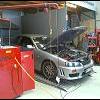Quick Turbo Comparison On Rb25
Announcements
-
Similar Content
-
Latest Posts
-
I don't like "actual computers" for in car use. They take time to boot up, have OS annoyances, and so on. Arduinos etc are ready to go a few seconds after power on, don't mind being agressively powere cycled, because everything is non-volatile, don't mind being shaken and stirred.
-
As Fred would tell us, it's all about interpreting the rules. It's not a water sprayer, it's a water mister... But everything else you've said, 100%! Even a raspberry Pi would be great, use HDMI out for a display, and add a raspberry Pi CANBus hat to read values out from the ECU.
-
Being a race car, and being in the era of the Arduino, one would think it would take little effort to build a controller to do the spraying based on a real physical measurment. Waaaaay back in the dim dark AS days, JE "designed" (as in, he had help) a microcontroller based intercooler spray system. It watched the difference between a temp sensor stuck on the core and one in the free air in front of the cooler, and if the temperature difference exceeded a (settable) threshold, it would activate the sprays. Thus, it only ran water when there was an actual need for water. If you stop to think about the actual physical things that are going on in that stack of coolers, there's probably at least a couple of triggering conditions one could come up with, and one could probably even run one pump with more than one solenoid valve, to allow water to be placed where it is needed, or at all points at once (if it is needed at all points). We're in the age of science baby. But.... I suspect that intercooler water sprays are on the forbidden list in most circuit classes, no? So only good for Targa type stuff?
-
I'll just leave this with, holy shit, those cars at work are awesome, and this will look wicked!
-
Could you modify this duct so instead it pushes the extra air through the radiator too and not down and out? For temps, I know it's not the greatest idea, but as a bit of a last resort, you could use a very intermittent misting spray onto the front of the coolers/rad. You don't want to be soaking them such that water is dripping off, but a small most on/off so that the water evaporates. That point of it constantly evaporating, rather than being soaked in water, will pull a LOT of heat out of the cooler. I'm literally thinking just the little mist sprayers for a garden from Bunnings. Being in a low humidity climate it will help even more! The other trick if you want to be ghetto is some shade cloth hung in the opening, and keep it wet. Pretty much now it's acting like an evap cooler on a house, but cooling the air you need to use to cool the radiator... On a topic to think about too though, when air enters through the bumper, is it all nicely ducted from the edges of that opening back at a nice angle, or is it like most cars, and the edge of the opening just stops, and suddenly it's wayyy wider behind that? If it does the later, get it shrouded out at nice angles. When that opening changes too rapidly, it can actually cause a high pressure zone between the front bar and radiator, and limit air flow into that area, which means less air for cooling, as it effectively stalls the air, AND adds to drag...
-






Recommended Posts
Create an account or sign in to comment
You need to be a member in order to leave a comment
Create an account
Sign up for a new account in our community. It's easy!
Register a new accountSign in
Already have an account? Sign in here.
Sign In Now